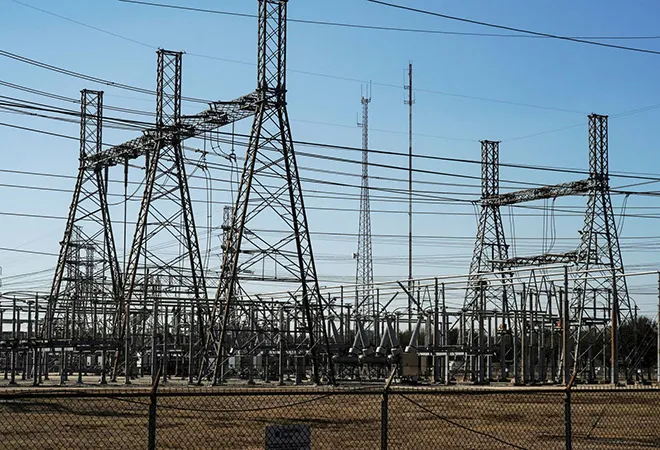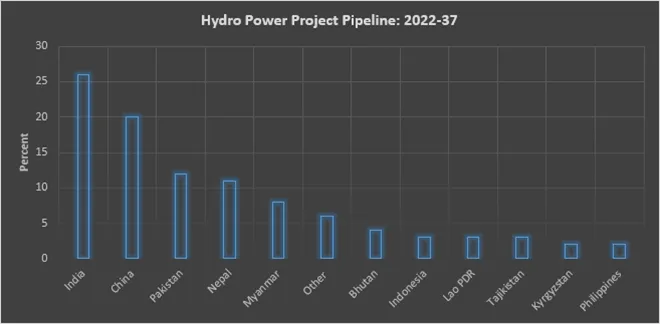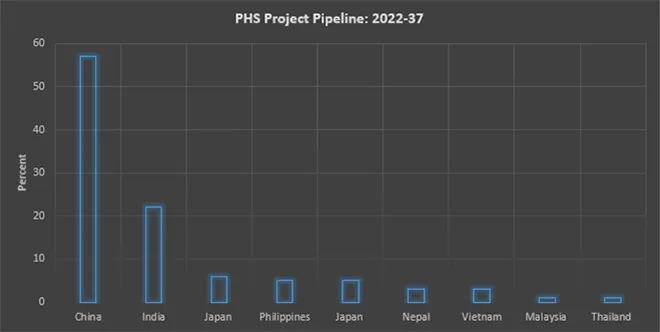
This article is part of the series
Comprehensive Energy Monitor: India and the World
Status
In 1947, hydropower capacity was about
37 percent of the total power generating capacity and over
53 percent of power generation. In the late 1960s, coal-based power generation started displacing hydropower in India and
hydropower’s share in both capacity and generation fell dramatically. In 2022-23, hydropower accounted for roughly
11.3 percent of power generation capacity with 46,850 MW (megawatt) and
9.9 percent of power generation in India. Small hydropower (below 25 MW) had an installed capacity of 4944 MW and
4745 MW of pumped hydro storage (PHS) capacity of which
3305 MW was used in pumped storage mode in 2022.
Globally, hydropower is the dominant renewable energy (RE) source to date, providing over
two-thirds of all renewable electricity. Hydropower accounted for about
18 percent of global installed power generating capacity and roughly
17 percent of power generation in 2020. Clean electricity generation from hydropower achieved a record
4,500 terawatt hours (TWh) in 2020 but fell to
4327 TWh in 2021 because of widespread droughts. Hydropower was the third largest source of electricity after coal and natural gas making the single largest contribution from an RE source in history; hydropower generation was
55 percent higher than nuclear power and higher than the electricity generated from all RE sources including wind and solar. Global growth in hydropower generation capacity was just over
1 percent in the last few years which is much lower than the
3 percent annual average growth required to meet net zero targets.
 Source: The Changing Role of Hydropower: IRENA 2023
Source: The Changing Role of Hydropower: IRENA 2023
Challenges
Large storage hydro-power projects produce low-carbon electricity but they also impose huge
local environmental and social costs. They displace thousands of people, disrupt
river ecology, resulting in large-scale deforestation, initiate loss of aquatic and terrestrial
biodiversity, and negatively alter food systems, water quality and agriculture. These environmental and social costs have led to
dam removals in North America and Europe that used to be big dam builders until the 1970s. Now more dams are
being removed in North America and Europe than are being built. Even in developing countries where dam building continues, the pace is slowing down because most of the best sites have been taken and also because other sources of RE such as solar and wind are monopolising
policy attention and investment.
In the fragile Himalayan mountains where most of India’s new hydro-power projects are being developed, devastating floods and landslides have
raised risk levels for hydro-projects. Some of the incidents that illustrate this challenge include the sudden flooding in the
Dhauliganga,
Rishiganga and
Alaknanda rivers in Uttarakhand’s Chamoli district in early February 2021 that took more than 70 lives and severely damaged NTPC’s (National Thermal Power Corporation) 520 MW (megawatt)
Tapovan-Vishnugad hydel project, the Uttarakhand Jal Vidyut Nigam’s 13.5 MW
Rishiganga Hydel Project, THDC’s (Tehri Hydropower Development Corporation) 444 MW
Pipal Koti project (which received World Bank assistance) and Jaiprakash Power Ventures’s 400 MW
Vishnuprayag project. Though there is
disagreement over the cause (glacier crash, avalanche, landslide), there is general agreement that carrying out development projects including hydropower projects, highways, railway lines and mining without
adequate appraisals and the disregard for cumulative impact and disaster potential assessments contributed to the scale of the loss. Widespread indifference to
environmental concerns among project developers and the absence of credible monitoring and compliance from regulatory bodies have considerably increased exposure to risks. But this does not mean hydropower projects must be abandoned. There are examples of hydropower projects in India that have met the best international standards. The
Teesta-V hydropower station, located in Sikkim was rated as an example of international good practice in hydropower sustainability in 2019. The 510 MW power station, owned and operated by NHPC Limited (National Hydropower Corporation), met or exceeded international
good practice across all 20 performance criteria. For hydropower planning to become sustainable in India the government and industry must prioritise transparency by engaging the civil society, especially those who are directly affected by the project. Research suggests
modular solutions that combine wind, solar, and hydropower provide alternative energy sources that are environmentally, socially, and financially desirable. Instream
turbine parks are much less disruptive alternatives to dams and produce energy at a much lower cost. Large, ‘
smart’ hydropower projects may be developed, taking into account the economic, environmental and social concerns of local and downstream communities, in addition to national economic benefits. Technical provisions in
smart projects can minimise the impacts on aquatic life and terrestrial ecosystems. To support hydropower projects, the government of India has included large projects above 25 MW under the renewable energy category and has notified
hydropower purchase obligation (HPO) as a non-solar renewable purchase obligation (RPO). To facilitate viability, tariff rationalisation with backloading of tariff after increasing project life to 40 years, increasing debt repayment period to 18 years and introducing escalating tariff of 2 percent,
budgetary support to building enabling infrastructure such as roads and bridges and also for flood moderation services have been introduced.
Contribution to grid stability
The most important advantage of hydropower in contrast to other REsources, like wind and solar, is that it can be dispatched quickly at any time, enabling utilities to
balance load variations on the electric distribution system. In India, hydropower’s load-following ability was best demonstrated on 5 April 2020 when the country’s operators restored grid stability following a
31 GW (gigawatts) plunge in demand when most households switched off electrical lights for nine minutes from
21.00 hours to 21.09 hrs. As the event unfolded, generation from hydropower was decreased by over
68 percent and then restored in a short period without which grid stability would have been compromised.
Pumped hydro storage (PHS) facilities
store energy in the form of potential energy of water in an upper reservoir, pumped from another reservoir at a lower elevation. During periods of high electricity demand, power is generated by releasing the
stored water through turbines in the same manner as a conventional hydropower station. During periods of low demand, the upper reservoir is recharged by using
lower-cost electricity from the grid to pump the water back to the upper reservoir. PHS projects are unlike traditional hydroelectric stations in that they are a
net consumer of electricity, due to hydraulic and electrical losses incurred in the cycle of pumping from lower to upper reservoirs. However, these plants are typically
highly efficient and can prove very beneficial in terms of balancing load within the overall power system. Pumped-storage facilities can be very economical due to
peak and off-peak price differentials and their potential to provide critical ancillary grid services. Globally, about
190 GW of PHS acts as the world’s largest ‘water battery’ accounting for over
85 percent of installed global energy storage capacity. It supports grid stability, reduces overall system costs and sector emissions. India has eight PHS plants with a combined capacity of
4745 MW in 2022. Only six plants with a combined capacity of around
3305 MW, are being operated in pumping mode. India has ambitious plans for PHS projects.
63 sites have been identified for PHS with a total potential of about
96,500 MW. As of 2022, PHS projects of capacity
5280 MW are under various stages of construction, projects of total capacity
16,770 MW are under various stages of investigation and projects of capacity
8855 MW are under preliminary studies. In 2020 the Solar Energy Corporation of India (SECI) concluded the world’s largest renewable-cum-energy storage power purchase tender through a reverse auction method. Greenko Group
won the auction with a peak power tariff rate of INR 6.12/kWh (kilowatt hour) pairing solar power with PHS.
Economics of PHS
No energy solution can exist outside of the real and competitive pressures of the market. Though a market for electricity does not exist in India in the strictest sense, PHS cannot count on technical viability and environmental benefits to succeed in the longer term. The traditional revenue source for
PHS is arbitrage: making the most of generating when the price is high, and pumping when the price is low. But this relies on a certain level of
predictable variability in the electricity market, and for that variability to continue into the future. PHS provides network support services such as frequency control, inertia and fault level control that have increasing value in a grid with significant amounts of non-synchronous solar and wind generation. As of now there are no markets for these
network support services but, in the future, the need for such services is likely to increase to the point where the market is willing to pay for it.
 Source: The Changing Role of Hydropower: IRENA 2023
Source: The Changing Role of Hydropower: IRENA 2023
The views expressed above belong to the author(s). ORF research and analyses now available on Telegram! Click here to access our curated content — blogs, longforms and interviews.



 This article is part of the series
This article is part of the series 

 PREV
PREV




